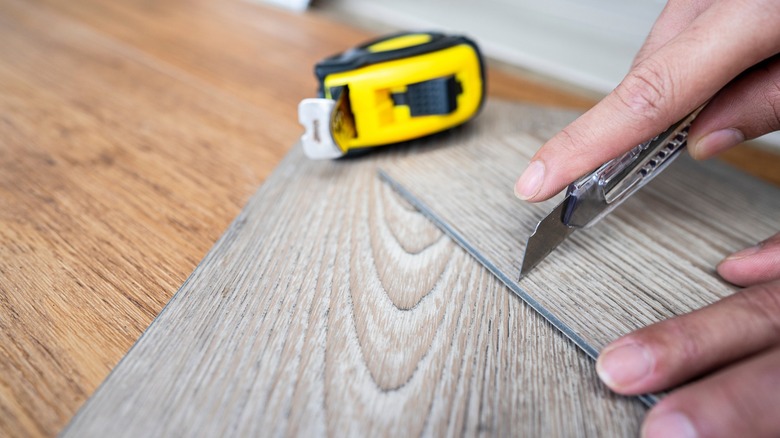How To Fix Your Vinyl Flooring Without Breaking The Bank
Getting a chip in a vinyl floor can cause a big headache, but before you start estimating replacement costs, you should know that minor vinyl floor repairs can often be handled without professional assistance. If it's just a small section of the floor that is damaged, you'll only need to replace that one area of vinyl, which is quite doable, even without technical expertise. All you need to do is get some vinyl floor material, cut out a piece that matches the size of the chip, and glue it into place. The vinyl flooring that you buy doesn't even need to be a precise match for your current floor — as long as the color and wood grain pattern are similar, it can work for a small floor repair. Plus, since vinyl flooring is often sold in cases, you can invest in one flooring purchase that will last you for many years' worth of minor repairs.
Simply put, you don't have to be a DIY expert to fix a small chip in your vinyl flooring. As long as you have a general ability to measure spaces, make clean cuts with a utility knife, and use glue, you should be able to cover up any of the tiny dings, chips, and missing chunks in your vinyl floors without blowing your household budget on costly professional floor repairs.
The easy way to fix vinyl flooring
Start by aligning the pattern on your new vinyl piece over the chipped area. Try to match the direction of the grain and depth of the wood stain of the damaged section. For more detailed wood grain patterns, you'll need to pay closer attention and line up the design precisely. Once the new vinyl is positioned correctly, use your utility knife to cut out a small square panel. The square should be just large enough to cover the chip. For a wood-style vinyl floor, you can make the panel the same width as the faux wooden plank. Alternatively, if matching the plank width isn't an option, try making it the same width as a single element in the fake wood, such as a strip of grain or a "knot" in the wood.
Next, using the utility knife, trace the cutout panel over the chipped section. This will remove the entire section around the chip so it aligns precisely with the new vinyl, ensuring that the panel can seamlessly fit into the space, like a perfect puzzle piece. Then, apply an adhesive of your choice to the exposed area of the floor. Put your new vinyl in place, applying gentle pressure so the panel lays smooth and makes full contact with the glue. If there's excess glue seeping out of the borders, use a clean microfiber cloth to wipe it away. And just like that, your vinyl floor is as good as new.
